Nsg5003 pulmonary - Study guides, Class notes & Summaries
Looking for the best study guides, study notes and summaries about Nsg5003 pulmonary? On this page you'll find 34 study documents about Nsg5003 pulmonary.
Page 3 out of 34 results
Sort by
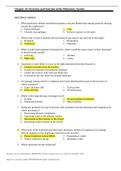
-
NSG 5003 / NSG5003 Chapter 34 Structure and Function Of the Pulmonary System GRADED A+
- Exam (elaborations) • 5 pages • 2021
-
- $10.49
- + learn more
NSG 5003 / NSG5003 Chapter 34 Structure and Function Of the Pulmonary System / NSG 5003 / NSG5003 Chapter 34 Structure and Function Of the Pulmonary System
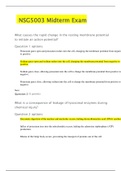
-
NSG5003 Midterm Exam Question And Answers( Complete Solution Rated A)
- Exam (elaborations) • 19 pages • 2021
- Available in package deal
-
- $18.39
- + learn more
NSG5003 Midterm Exam What causes the rapid change in the resting membrane potential to initiate an action potential? Question 1 options: Potassium gates open and potassium rushes into the cell, changing the membrane potential from negative to positive Sodium gates open and sodium rushes into the cell, changing the membrane potential from negative to positive. Sodium gates close, allowing potassium into the cell to change the membrane potential from positive to negative. Potassium gates close, al...
![NSG5003 FAMILY NUR|FAMILY NURNSG5003 Week 10 Final Guide 2020/2021...[Recent]](/docpics/5f58a55c7eb76_815588.jpg)
-
NSG5003 FAMILY NUR|FAMILY NURNSG5003 Week 10 Final Guide 2020/2021...[Recent]
- Study guide • 53 pages • 2020
-
- $11.39
- 1x sold
- + learn more
FAMILY NUR NSG5003 Week 10 Final Guide 1. It is important to not dilate the eye if ____ is suspected. Question 2. 2. An 18-year-old female patient presents with repeated urinary tract infections. She has no risk factors in her history, and her physical examination is unremarkable. She also has a normal pelvic exam. Which of the following should be obtained if anatomic abnormalities are suspected? Question 3. 3. The pathophysiological hallmark of ACD is: Question 4...
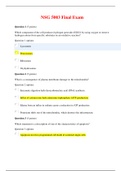
-
SOUTH UNIVERSITY NSG5003 ADVANCED PATHOPHYSIOLOGY FINAL EXAM 2020 (VERSION-1)|100% CORRECT ANSWERS, DOWNLOAD TO SCORE A|
- Exam (elaborations) • 19 pages • 2020
- Available in package deal
-
- $18.49
- + learn more
NSG5003 Final Exam / NSG 5003 Final Exam: Advanced pathophysiology: South University South University NSG5003 Final Exam / South University NSG 5003 Final Exam Question 1 (5 points) Which component of the cell produces hydrogen peroxide (H2O2) by using oxygen to remove hydrogen atoms from specific substrates in an oxidative reaction? Question 1 options: Lysosomes Peroxisomes Ribosomes Oxyhydrosomes Question 2 (5 points) What is a consequence of plasma membrane damage to the mitocho...
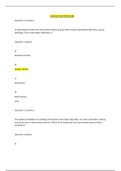
-
NSG 5003 MIDTERM EXAM / NSG5003 MIDTERM EXAM (VERSION -2, LATEST, 2020): ADVANCED PATHOPHYSIOLOGY : SOUTH UNIVERSITY |100% CORRECT ANSWERS, DOWNLOAD TO SCORE A|
- Exam (elaborations) • 70 pages • 2020
- Available in package deal
-
- $18.49
- + learn more
NSG5003 Midterm Exam / NSG 5003 Midterm Exam: Advanced pathophysiology: South University South University NSG5003 Midterm Exam / South University NSG 5003 Midterm Exam Question 1 (2 points) In examination of the nose, the clinician observes gray, pale mucous membranes with clear, serous discharge. This is most likely indicative of: Question 1 options: a) Bacterial sinusitis b) Allergic rhinitis c) Drug abuse d) Skull fracture Save Question 2 (2 points) Your patient complains of a f...
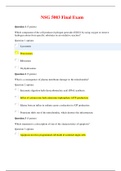
-
NSG 5003 FINAL EXAM / NSG5003 FINAL EXAM (VERSION-1, LATEST- 2020): ADVANCED PATHOPHYSIOLOGY: SOUTH UNIVERSITY |100% CORRECT ANSWERS, DOWNLOAD TO SCORE A|
- Exam (elaborations) • 19 pages • 2020
- Available in package deal
-
- $18.49
- + learn more
NSG5003 Final Exam / NSG 5003 Final Exam: Advanced pathophysiology: South University South University NSG5003 Final Exam / South University NSG 5003 Final Exam Question 1 (5 points) Which component of the cell produces hydrogen peroxide (H2O2) by using oxygen to remove hydrogen atoms from specific substrates in an oxidative reaction? Question 1 options: Lysosomes Peroxisomes Ribosomes Oxyhydrosomes Question 2 (5 points) What is a consequence of plasma membrane damage to the mitocho...
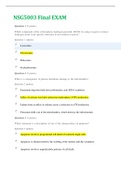
-
NSG5003 Final EXAM (RATED A) Q & A Solutions | Download To Score An A | South University, Savannah.
- Exam (elaborations) • 19 pages • 2021
-
- $10.99
- + learn more
NSG5003 Final EXAM Question 1 (5 points) Which component of the cell produces hydrogen peroxide (H2O2) by using oxygen to remove hydrogen atoms from specific substrates in an oxidative reaction? Question 1 options: Peroxisomes Ribosomes Oxyhydrosomes Question 2 (5 points) What is a consequence of plasma membrane damage to the mitochondria? Question 2 options: Enzymatic digestion halts deoxyribonucleic acid (DNA) synthesis. Influx of calcium ions halts adenosine triphosphate (ATP) production. Ede...
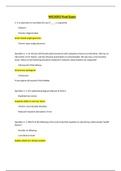
-
SOUTH UNIVERSITY NSG5003 ADVANCED PATHOPHYSIOLOGY FINAL EXAM 2020 (VERSION-2)|100% CORRECT ANSWERS, DOWNLOAD TO SCORE A|
- Exam (elaborations) • 53 pages • 2020
- Available in package deal
-
- $18.49
- + learn more
NSG5003 Final Exam / NSG 5003 Final Exam: Advanced pathophysiology: South University South University NSG5003 Final Exam / South University NSG 5003 Final Exam 1. It is important to not dilate the eye if ____ is suspected. Cataract Macular degeneration Acute closed-angle glaucoma Chronic open-angle glaucoma Question 2. 2. An 18-year-old female patient presents with repeated urinary tract infections. She has no risk factors in her history, and her physical examination is...
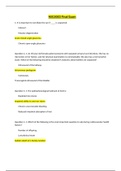
-
NSG 5003 FINAL EXAM / NSG5003 FINAL EXAM (VERSION-2, LATEST- 2020): ADVANCED PATHOPHYSIOLOGY: SOUTH UNIVERSITY |100% CORRECT ANSWERS, DOWNLOAD TO SCORE A|
- Exam (elaborations) • 53 pages • 2020
- Available in package deal
-
- $18.49
- + learn more
NSG5003 Final Exam / NSG 5003 Final Exam: Advanced pathophysiology: South University South University NSG5003 Final Exam / South University NSG 5003 Final Exam 1. It is important to not dilate the eye if ____ is suspected. Cataract Macular degeneration Acute closed-angle glaucoma Chronic open-angle glaucoma Question 2. 2. An 18-year-old female patient presents with repeated urinary tract infections. She has no risk factors in her history, and her physical examination is...
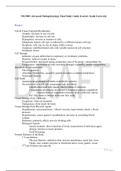
-
NSG5003 Advanced Pathophysiology Final Study Guide (Latest): South University
- Study guide • 45 pages • 2020
- Available in package deal
-
- $17.49
- 1x sold
- + learn more
NSG5003 Advanced Pathophysiology Final Study Guide (Latest): South University Week 1 Cell & Tissue Function/Dysfunction Atrophy: decrease in size of cells. Hypertrophy: increase in cell size. Hyperplasia: increase in number of cells. Metaplasia: mature cell type is replaced by a different mature cell type. Dysplasia: cells vary in size & shape within a tissue. Anaplasia: undifferentiated cells with variable nuclear & cell structure. Neoplasm: tumor. Cell Damage Ischemia: oxygen deficit due t...

How did he do that? By selling his study resources on Stuvia. Try it yourself! Discover all about earning on Stuvia


